How To Import Sfm Animations Across Computers
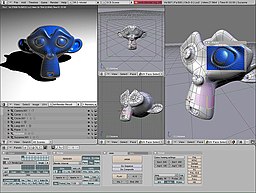
Computer graphics deals with generating images with the aid of computers. Today, figurer graphics is a core applied science in digital photography, movie, video games, prison cell telephone and figurer displays, and many specialized applications. A great deal of specialized hardware and software has been adult, with the displays of most devices being driven by computer graphics hardware. It is a vast and recently developed area of informatics. The phrase was coined in 1960 by computer graphics researchers Verne Hudson and William Fetter of Boeing. It is often abbreviated as CG, or typically in the context of film equally computer generated imagery (CGI). The non-creative aspects of computer graphics are the subject field of calculator science inquiry.[1]
Some topics in computer graphics include user interface design, sprite graphics, rendering, ray tracing, geometry processing, reckoner animation, vector graphics, 3D modeling, shaders, GPU design, implicit surfaces, visualization, scientific computing, paradigm processing, computational photography, scientific visualization, computational geometry and computer vision, among others. The overall methodology depends heavily on the underlying sciences of geometry, optics, physics, and perception.
Estimator graphics is responsible for displaying art and prototype data effectively and meaningfully to the consumer. It is as well used for processing epitome data received from the physical world, such as photo and video content. Figurer graphics evolution has had a pregnant impact on many types of media and has revolutionized animation, movies, advertizement, video games, in general.
Overview [edit]
The term estimator graphics has been used in a broad sense to describe "near everything on computers that is not text or audio".[ii] Typically, the term reckoner graphics refers to several different things:
- the representation and manipulation of image information by a computer
- the various technologies used to create and manipulate images
- methods for digitally synthesizing and manipulating visual content, come across report of computer graphics
Today, figurer graphics is widespread. Such imagery is plant in and on television, newspapers, weather reports, and in a diversity of medical investigations and surgical procedures. A well-constructed graph can nowadays circuitous statistics in a grade that is easier to understand and interpret. In the media "such graphs are used to illustrate papers, reports, theses", and other presentation material.[3]
Many tools have been developed to visualize data. Estimator-generated imagery can be categorized into several unlike types: ii dimensional (2d), three dimensional (3D), and animated graphics. As applied science has improved, 3D computer graphics have become more mutual, but 2D computer graphics are still widely used. Computer graphics has emerged as a sub-field of informatics which studies methods for digitally synthesizing and manipulating visual content. Over the by decade, other specialized fields accept been adult like information visualization, and scientific visualization more concerned with "the visualization of 3 dimensional phenomena (architectural, meteorological, medical, biological, etc.), where the emphasis is on realistic renderings of volumes, surfaces, illumination sources, and and then along, perchance with a dynamic (time) component".[4]
History [edit]
The forerunner sciences to the development of modern computer graphics were the advances in electrical engineering, electronics, and idiot box that took place during the first half of the twentieth century. Screens could display art since the Lumiere brothers' use of mattes to create special effects for the primeval films dating from 1895, merely such displays were limited and not interactive. The kickoff cathode ray tube, the Braun tube, was invented in 1897 – information technology in plow would permit the oscilloscope and the military command panel – the more direct precursors of the field, as they provided the first 2-dimensional electronic displays that responded to programmatic or user input. Nevertheless, computer graphics remained relatively unknown equally a discipline until the 1950s and the postal service-World War Two catamenia – during which fourth dimension the discipline emerged from a combination of both pure academy and laboratory academic research into more than advanced computers and the United States military machine'due south farther development of technologies similar radar, advanced aviation, and rocketry developed during the state of war. New kinds of displays were needed to procedure the wealth of information resulting from such projects, leading to the evolution of computer graphics as a discipline.
1950s [edit]
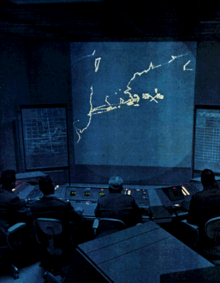
SAGE Sector Control Room.
Early projects like the Cyclone and SAGE Projects introduced the CRT equally a viable display and interaction interface and introduced the light pen as an input device. Douglas T. Ross of the Cyclone SAGE system performed a personal experiment in which he wrote a small-scale program that captured the move of his finger and displayed its vector (his traced name) on a brandish telescopic. One of the first interactive video games to characteristic recognizable, interactive graphics – Tennis for Two – was created for an oscilloscope by William Higinbotham to entertain visitors in 1958 at Brookhaven National Laboratory and simulated a lawn tennis lucifer. In 1959, Douglas T. Ross innovated again while working at MIT on transforming mathematic statements into estimator generated 3D machine tool vectors by taking the opportunity to create a display telescopic image of a Disney cartoon character.[5]
Electronics pioneer Hewlett-Packard went public in 1957 after incorporating the decade prior, and established potent ties with Stanford University through its founders, who were alumni. This began the decades-long transformation of the southern San Francisco Bay Surface area into the world'south leading computer technology hub – now known as Silicon Valley. The field of computer graphics developed with the emergence of computer graphics hardware.
Further advances in calculating led to greater advancements in interactive computer graphics. In 1959, the TX-2 computer was developed at MIT's Lincoln Laboratory. The TX-2 integrated a number of new homo-machine interfaces. A light pen could be used to depict sketches on the computer using Ivan Sutherland'south revolutionary Sketchpad software.[6] Using a light pen, Sketchpad allowed one to describe elementary shapes on the estimator screen, save them and fifty-fifty recall them later on. The low-cal pen itself had a small-scale photoelectric cell in its tip. This cell emitted an electronic pulse whenever it was placed in front end of a computer screen and the screen'south electron gun fired directly at it. By simply timing the electronic pulse with the current location of the electron gun, it was piece of cake to pinpoint exactly where the pen was on the screen at whatever given moment. Once that was adamant, the computer could so draw a cursor at that location. Sutherland seemed to observe the perfect solution for many of the graphics problems he faced. Fifty-fifty today, many standards of computer graphics interfaces got their showtime with this early Sketchpad program. 1 case of this is in drawing constraints. If i wants to draw a square for example, they practice non have to worry about cartoon four lines perfectly to course the edges of the box. Ane tin simply specify that they want to describe a box, and and so specify the location and size of the box. The software will then construct a perfect box, with the correct dimensions and at the right location. Another instance is that Sutherland'south software modeled objects – not merely a moving-picture show of objects. In other words, with a model of a car, one could change the size of the tires without affecting the rest of the motorcar. It could stretch the body of machine without deforming the tires.
1960s [edit]
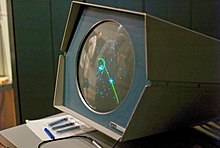
The phrase "computer graphics" has been credited to William Fetter, a graphic designer for Boeing in 1960. Fetter in plough attributed it to Verne Hudson, also at Boeing.[6] [7]
In 1961 another student at MIT, Steve Russell, created some other important title in the history of video games, Spacewar! Written for the DEC PDP-1, Spacewar was an instant success and copies started flowing to other PDP-1 owners and eventually DEC got a re-create.[ citation needed ] The engineers at Dec used it as a diagnostic program on every new PDP-i before shipping information technology. The sales force picked up on this apace enough and when installing new units, would run the "world's get-go video game" for their new customers. (Higginbotham'southward Lawn tennis For Two had beaten Spacewar by almost three years, simply information technology was almost unknown outside of a enquiry or academic setting.)
At around the same time (1961–1962) in the University of Cambridge, Elizabeth Waldram wrote code to display radio-astronomy maps on a cathode ray tube.[viii]
E. East. Zajac, a scientist at Bell Telephone Laboratory (BTL), created a film called "Simulation of a two-giro gravity attitude control organisation" in 1963.[nine] In this computer-generated film, Zajac showed how the attitude of a satellite could be altered as information technology orbits the Earth. He created the animation on an IBM 7090 mainframe calculator. Also at BTL, Ken Knowlton, Frank Sinden, Ruth A. Weiss and Michael Noll started working in the figurer graphics field. Sinden created a film called Force, Mass and Motion illustrating Newton'southward laws of move in performance. Around the same time, other scientists were creating computer graphics to illustrate their inquiry. At Lawrence Radiations Laboratory, Nelson Max created the films Period of a Glutinous Fluid and Propagation of Stupor Waves in a Solid Course. Boeing Shipping created a film called Vibration of an Aircraft.
As well sometime in the early 1960s, automobiles would likewise provide a boost through the early work of Pierre Bézier at Renault, who used Paul de Casteljau's curves – now called Bézier curves after Bézier'due south piece of work in the field – to develop 3d modeling techniques for Renault motorcar bodies. These curves would form the foundation for much bend-modeling work in the field, equally curves – unlike polygons – are mathematically circuitous entities to describe and model well.
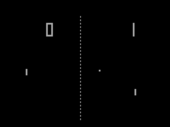
Information technology was not long before major corporations started taking an involvement in computer graphics. TRW, Lockheed-Georgia, General Electric and Sperry Rand are among the many companies that were getting started in computer graphics past the mid-1960s. IBM was quick to answer to this interest past releasing the IBM 2250 graphics last, the first commercially available graphics computer. Ralph Baer, a supervising engineer at Sanders Associates, came up with a home video game in 1966 that was afterwards licensed to Magnavox and called the Odyssey. While very simplistic, and requiring fairly inexpensive electronic parts, it allowed the player to move points of low-cal around on a screen. Information technology was the starting time consumer computer graphics product. David C. Evans was managing director of engineering at Bendix Corporation's computer sectionalisation from 1953 to 1962, after which he worked for the next five years as a visiting professor at Berkeley. There he continued his interest in computers and how they interfaced with people. In 1966, the Academy of Utah recruited Evans to form a computer science program, and estimator graphics quickly became his master involvement. This new department would become the globe'south primary inquiry center for computer graphics through the 1970s.
As well, in 1966, Ivan Sutherland continued to innovate at MIT when he invented the outset estimator-controlled caput-mounted display (HMD). It displayed ii separate wireframe images, i for each heart. This allowed the viewer to see the computer scene in stereoscopic 3D. The heavy hardware required for supporting the display and tracker was called the Sword of Damocles because of the potential danger if information technology were to fall upon the wearer. Later receiving his Ph.D. from MIT, Sutherland became Director of Information Processing at ARPA (Advanced Research Projects Agency), and later became a professor at Harvard. In 1967 Sutherland was recruited by Evans to bring together the computer science program at the University of Utah – a development which would turn that department into i of the most of import research centers in graphics for nearly a decade thereafter, eventually producing some of the most important pioneers in the field. There Sutherland perfected his HMD; twenty years later, NASA would re-find his techniques in their virtual reality research. At Utah, Sutherland and Evans were highly sought after consultants by large companies, but they were frustrated at the lack of graphics hardware available at the time, then they started formulating a programme to get-go their ain company.
In 1968, Dave Evans and Ivan Sutherland founded the get-go calculator graphics hardware company, Evans & Sutherland. While Sutherland originally wanted the visitor to be located in Cambridge, Massachusetts, Salt Lake Urban center was instead chosen due to its proximity to the professors' inquiry grouping at the Academy of Utah.
Besides in 1968 Arthur Appel described the first ray casting algorithm, the first of a class of ray tracing-based rendering algorithms that have since go key in achieving photorealism in graphics past modeling the paths that rays of light take from a lite source, to surfaces in a scene, and into the camera.
In 1969, the ACM initiated A Special Involvement Group on Graphics (SIGGRAPH) which organizes conferences, graphics standards, and publications within the field of computer graphics. By 1973, the first almanac SIGGRAPH briefing was held, which has become one of the focuses of the organization. SIGGRAPH has grown in size and importance equally the field of computer graphics has expanded over time.
1970s [edit]
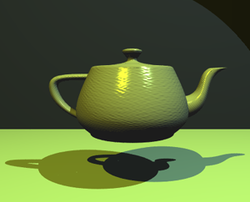
Afterwards, a number of breakthroughs in the field – specially important early on breakthroughs in the transformation of graphics from utilitarian to realistic – occurred at the Academy of Utah in the 1970s, which had hired Ivan Sutherland. He was paired with David C. Evans to teach an advanced computer graphics class, which contributed a great deal of founding research to the field and taught several students who would grow to establish several of the manufacture'southward most of import companies – namely Pixar, Silicon Graphics, and Adobe Systems. Tom Stockham led the paradigm processing group at UU which worked closely with the computer graphics lab.
One of these students was Edwin Catmull. Catmull had just come from The Boeing Company and had been working on his degree in physics. Growing up on Disney, Catmull loved blitheness yet quickly discovered that he did not take the talent for cartoon. At present Catmull (along with many others) saw computers equally the natural progression of animation and they wanted to exist function of the revolution. The first figurer blitheness that Catmull saw was his own. He created an animation of his hand opening and closing. He as well pioneered texture mapping to paint textures on three-dimensional models in 1974, now considered one of the fundamental techniques in 3D modeling. It became ane of his goals to produce a feature-length motility moving picture using reckoner graphics – a goal he would reach two decades later afterward his founding role in Pixar. In the same class, Fred Parke created an animation of his wife'due south face. The ii animations were included in the 1976 feature film Futureworld.
Equally the UU calculator graphics laboratory was attracting people from all over, John Warnock was another of those early on pioneers; he later founded Adobe Systems and create a revolution in the publishing world with his PostScript folio clarification language, and Adobe would go on later to create the industry standard photo editing software in Adobe Photoshop and a prominent movie manufacture special effects program in Adobe Later Effects.
James Clark was likewise there; he later founded Silicon Graphics, a maker of advanced rendering systems that would boss the field of loftier-end graphics until the early 1990s.
A major accelerate in 3D figurer graphics was created at UU by these early pioneers – hidden surface determination. In lodge to depict a representation of a 3D object on the screen, the reckoner must determine which surfaces are "behind" the object from the viewer's perspective, and thus should exist "hidden" when the computer creates (or renders) the prototype. The 3D Core Graphics System (or Core) was the first graphical standard to exist developed. A group of 25 experts of the ACM Special Interest Group SIGGRAPH developed this "conceptual framework". The specifications were published in 1977, and information technology became a foundation for many future developments in the field.
Also in the 1970s, Henri Gouraud, Jim Blinn and Bui Tuong Phong contributed to the foundations of shading in CGI via the development of the Gouraud shading and Blinn–Phong shading models, allowing graphics to move beyond a "flat" await to a expect more accurately portraying depth. Jim Blinn too innovated further in 1978 by introducing bump mapping, a technique for simulating uneven surfaces, and the predecessor to many more than advanced kinds of mapping used today.
The modern videogame arcade as is known today was birthed in the 1970s, with the get-go arcade games using real-time 2D sprite graphics. Pong in 1972 was 1 of the first hit arcade cabinet games. Speed Race in 1974 featured sprites moving forth a vertically scrolling road. Gun Fight in 1975 featured human-looking animated characters, while Space Invaders in 1978 featured a large number of blithe figures on screen; both used a specialized barrel shifter circuit fabricated from discrete chips to assist their Intel 8080 microprocessor animate their framebuffer graphics.
1980s [edit]
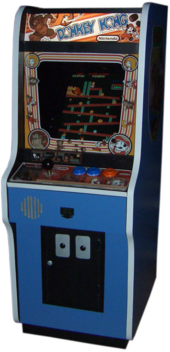
Donkey Kong was one of the video games that helped to popularize reckoner graphics to a mass audition in the 1980s.
The 1980s began to see the modernization and commercialization of figurer graphics. As the domicile computer proliferated, a subject area which had previously been an academics-only discipline was adopted by a much larger audience, and the number of computer graphics developers increased significantly.
In the early 1980s, metal–oxide–semiconductor (MOS) very-large-scale integration (VLSI) technology led to the availability of sixteen-bit central processing unit (CPU) microprocessors and the first graphics processing unit (GPU) fries, which began to revolutionize reckoner graphics, enabling high-resolution graphics for computer graphics terminals every bit well as personal computer (PC) systems. NEC's µPD7220 was the outset GPU, fabricated on a fully integrated NMOS VLSI chip. It supported upwardly to 1024x1024 resolution, and laid the foundations for the emerging PC graphics market. It was used in a number of graphics cards, and was licensed for clones such equally the Intel 82720, the kickoff of Intel's graphics processing units.[10] MOS memory as well became cheaper in the early 1980s, enabling the development of affordable framebuffer memory,[11] notably video RAM (VRAM) introduced by Texas Instruments (TI) in the mid-1980s.[12] In 1984, Hitachi released the ARTC HD63484, the first complementary MOS (CMOS) GPU. It was capable of displaying high-resolution in color mode and up to 4K resolution in monochrome manner, and it was used in a number of graphics cards and terminals during the tardily 1980s.[xiii] In 1986, TI introduced the TMS34010, the first fully programmable MOS graphics processor.[12]
Computer graphics terminals during this decade became increasingly intelligent, semi-standalone and standalone workstations. Graphics and application processing were increasingly migrated to the intelligence in the workstation, rather than continuing to rely on central mainframe and mini-computers. Typical of the early motility to loftier-resolution computer graphics intelligent workstations for the figurer-aided engineering market were the Orca m, 2000 and 3000 workstations, developed past Orcatech of Ottawa, a spin-off from Bell-Northern Research, and led past David Pearson, an early workstation pioneer. The Orca 3000 was based on the 16-bit Motorola 68000 microprocessor and AMD scrap-piece processors, and had Unix equally its operating system. It was targeted squarely at the sophisticated cease of the pattern engineering sector. Artists and graphic designers began to run across the personal reckoner, peculiarly the Commodore Amiga and Macintosh, as a serious design tool, one that could salvage time and draw more accurately than other methods. The Macintosh remains a highly popular tool for computer graphics among graphic design studios and businesses. Modernistic computers, dating from the 1980s, often utilise graphical user interfaces (GUI) to present data and data with symbols, icons and pictures, rather than text. Graphics are 1 of the five key elements of multimedia technology.
In the field of realistic rendering, Nihon's Osaka University adult the LINKS-1 Computer Graphics Organisation, a supercomputer that used up to 257 Zilog Z8001 microprocessors, in 1982, for the purpose of rendering realistic 3D calculator graphics. According to the Information Processing Society of Japan: "The core of 3D image rendering is calculating the luminance of each pixel making up a rendered surface from the given viewpoint, calorie-free source, and object position. The LINKS-ane arrangement was developed to realize an prototype rendering methodology in which each pixel could be parallel processed independently using ray tracing. By developing a new software methodology specifically for high-speed image rendering, LINKS-ane was able to speedily render highly realistic images. It was used to create the globe's showtime 3D planetarium-similar video of the unabridged heavens that was fabricated completely with computer graphics. The video was presented at the Fujitsu pavilion at the 1985 International Exposition in Tsukuba."[14] The LINKS-1 was the earth's most powerful reckoner, as of 1984.[15] Too in the field of realistic rendering, the general rendering equation of David Immel and James Kajiya was developed in 1986 – an important step towards implementing global illumination, which is necessary to pursue photorealism in estimator graphics.
The standing popularity of Star Wars and other scientific discipline fiction franchises were relevant in cinematic CGI at this fourth dimension, as Lucasfilm and Industrial Light & Magic became known as the "go-to" house by many other studios for topnotch computer graphics in film. Of import advances in blush keying ("bluescreening", etc.) were made for the later films of the original trilogy. Two other pieces of video would too outlast the era every bit historically relevant: Dire Straits' iconic, near-fully-CGI video for their vocal "Coin for Naught" in 1985, which popularized CGI amidst music fans of that era, and a scene from Young Sherlock Holmes the same year featuring the outset fully CGI graphic symbol in a feature movie (an animated stained-glass knight). In 1988, the first shaders – small programs designed specifically to exercise shading as a carve up algorithm – were developed by Pixar, which had already spun off from Industrial Light & Magic equally a separate entity – though the public would not see the results of such technological progress until the adjacent decade. In the tardily 1980s, Silicon Graphics (SGI) computers were used to create some of the first fully figurer-generated short films at Pixar, and Silicon Graphics machines were considered a high-h2o mark for the field during the decade.
The 1980s is also chosen the golden era of videogames; millions-selling systems from Atari, Nintendo and Sega, amid other companies, exposed estimator graphics for the first time to a new, immature, and impressionable audition – as did MS-DOS-based personal computers, Apple IIs, Macs, and Amigas, all of which also allowed users to plan their ain games if skilled plenty. For the arcades, advances were made in commercial, real-time 3D graphics. In 1988, the first dedicated real-time 3D graphics boards were introduced for arcades, with the Namco System 21[16] and Taito Air System.[17] On the professional side, Evans & Sutherland and SGI adult 3D raster graphics hardware that directly influenced the later single-chip graphics processing unit of measurement (GPU), a engineering science where a separate and very powerful chip is used in parallel processing with a CPU to optimize graphics.
The decade too saw computer graphics practical to many boosted professional markets, including location-based entertainment and instruction with the East&S Digistar, vehicle design, vehicle simulation, and chemistry.
1990s [edit]

The 1990s' overwhelming note was the emergence of 3D modeling on a mass scale and an impressive rise in the quality of CGI mostly. Home computers became able to accept on rendering tasks that previously had been limited to workstations costing thousands of dollars; every bit 3D modelers became available for home systems, the popularity of Silicon Graphics workstations declined and powerful Microsoft Windows and Apple Macintosh machines running Autodesk products similar 3D Studio or other home rendering software ascended in importance. By the end of the decade, the GPU would begin its rise to the prominence it still enjoys today.
The field began to see the kickoff rendered graphics that could truly laissez passer as photorealistic to the untrained eye (though they could not yet do and then with a trained CGI artist) and 3D graphics became far more popular in gaming, multimedia, and animation. At the end of the 1980s and the commencement of the nineties were created, in France, the very first estimator graphics Tv series: La Vie des bêtes past studio Mac Guff Ligne (1988), Les Fables Géométriques (1989–1991) past studio Fantôme, and Quarxs, the starting time HDTV calculator graphics series by Maurice Benayoun and François Schuiten (studio Z-A production, 1990–1993).
In motion-picture show, Pixar began its serious commercial rise in this era under Edwin Catmull, with its first major picture show release, in 1995 – Toy Story – a critical and commercial success of ix-figure magnitude. The studio to invent the programmable shader would get on to have many animated hits, and its work on prerendered video animation is still considered an industry leader and inquiry trail breaker.
In video games, in 1992, Virtua Racing, running on the Sega Model 1 arcade organization lath, laid the foundations for fully 3D racing games and popularized real-time 3D polygonal graphics amidst a wider audience in the video game industry.[xviii] The Sega Model 2 in 1993 and Sega Model 3 in 1996 subsequently pushed the boundaries of commercial, real-time 3D graphics. Dorsum on the PC, Wolfenstein 3D, Doom and Quake, iii of the commencement massively popular 3D first-person shooter games, were released by id Software to critical and popular acclaim during this decade using a rendering engine innovated[ vague ] primarily by John Carmack. The Sony PlayStation, Sega Saturn, and Nintendo 64, among other consoles, sold in the millions and popularized 3D graphics for home gamers. Certain tardily-1990s first-generation 3D titles became seen as influential in popularizing 3D graphics among panel users, such every bit platform games Super Mario 64 and The Legend Of Zelda: Ocarina Of Fourth dimension, and early 3D fighting games like Virtua Fighter, Battle Arena Toshinden, and Tekken.
Engineering and algorithms for rendering connected to meliorate greatly. In 1996, Krishnamurty and Levoy invented normal mapping – an improvement on Jim Blinn's bump mapping. 1999 saw Nvidia release the seminal GeForce 256, the first home video menu billed as a graphics processing unit or GPU, which in its own words independent "integrated transform, lighting, triangle setup/clipping, and rendering engines". By the end of the decade, computers adopted common frameworks for graphics processing such equally DirectX and OpenGL. Since and so, calculator graphics take only go more detailed and realistic, due to more powerful graphics hardware and 3D modeling software. AMD also became a leading developer of graphics boards in this decade, creating a "duopoly" in the field which exists this day.
2000s [edit]
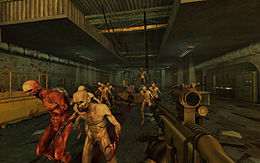
CGI became ubiquitous in hostage during this era. Video games and CGI cinema had spread the achieve of estimator graphics to the mainstream past the late 1990s and continued to practise so at an accelerated pace in the 2000s. CGI was also adopted en masse for television advertisements widely in the belatedly 1990s and 2000s, and so became familiar to a massive audience.
The continued rise and increasing composure of the graphics processing unit were crucial to this decade, and 3D rendering capabilities became a standard characteristic as 3D-graphics GPUs became considered a necessity for desktop reckoner makers to offer. The Nvidia GeForce line of graphics cards dominated the market in the early decade with occasional significant competing presence from ATI.[xix] Equally the decade progressed, even low-finish machines usually contained a 3D-capable GPU of some kind as Nvidia and AMD both introduced low-priced chipsets and connected to dominate the market. Shaders which had been introduced in the 1980s to perform specialized processing on the GPU would by the end of the decade become supported on virtually consumer hardware, speeding upwards graphics considerably and allowing for greatly improved texture and shading in calculator graphics via the widespread adoption of normal mapping, crash-land mapping, and a variety of other techniques assuasive the simulation of a keen amount of detail.
Reckoner graphics used in films and video games gradually began to be realistic to the bespeak of entering the uncanny valley. CGI movies proliferated, with traditional animated cartoon films like Water ice Historic period and Madagascar as well every bit numerous Pixar offerings similar Finding Nemo dominating the box part in this field. The Last Fantasy: The Spirits Within, released in 2001, was the offset fully estimator-generated characteristic film to use photorealistic CGI characters and be fully made with motion capture.[20] The film was not a box-office success, still.[21] Some commentators have suggested this may exist partly considering the lead CGI characters had facial features which vicious into the "uncanny valley".[note 1] Other animated films like The Polar Express drew attention at this time likewise. Star Wars also resurfaced with its prequel trilogy and the effects connected to set a bar for CGI in moving picture.
In videogames, the Sony PlayStation 2 and 3, the Microsoft Xbox line of consoles, and offerings from Nintendo such as the GameCube maintained a large post-obit, every bit did the Windows PC. Marquee CGI-heavy titles like the serial of 1000 Theft Auto, Assassin'due south Creed, Final Fantasy, BioShock, Kingdom Hearts, Mirror'southward Border and dozens of others continued to approach photorealism, abound the video game industry and impress, until that manufacture's revenues became comparable to those of movies. Microsoft fabricated a decision to expose DirectX more easily to the independent developer earth with the XNA program, but it was non a success. DirectX itself remained a commercial success, nevertheless. OpenGL continued to mature as well, and it and DirectX improved greatly; the second-generation shader languages HLSL and GLSL began to be popular in this decade.
In scientific computing, the GPGPU technique to laissez passer large amounts of data bidirectionally between a GPU and CPU was invented; speeding upward analysis on many kinds of bioinformatics and molecular biology experiments. The technique has also been used for Bitcoin mining and has applications in computer vision.
2010s [edit]
| | This section needs expansion. You can help past adding to it. (Oct 2014) |
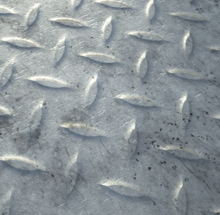
In the 2010s, CGI has been nearly ubiquitous in video, pre-rendered graphics are well-nigh scientifically photorealistic, and real-time graphics on a suitably loftier-cease system may simulate photorealism to the untrained center.
Texture mapping has matured into a multistage process with many layers; generally, it is not uncommon to implement texture mapping, bump mapping or isosurfaces or normal mapping, lighting maps including specular highlights and reflection techniques, and shadow volumes into one rendering engine using shaders, which are maturing considerably. Shaders are now very nearly a necessity for advanced work in the field, providing considerable complication in manipulating pixels, vertices, and textures on a per-element basis, and countless possible effects. Their shader languages HLSL and GLSL are active fields of inquiry and development. Physically based rendering or PBR, which implements many maps and performs avant-garde calculation to simulate real optic light flow, is an active research area also, along with advanced areas similar ambient occlusion, subsurface scattering, Rayleigh handful, photon mapping, and many others. Experiments into the processing power required to provide graphics in real time at ultra-high-resolution modes like 4K Ultra HD are get-go, though beyond accomplish of all but the highest-stop hardware.
In movie house, most animated movies are CGI now; a great many animated CGI films are made per year, but few, if any, endeavour photorealism due to continuing fears of the uncanny valley. Near are 3D cartoons.
In videogames, the Microsoft Xbox Ane, Sony PlayStation 4, and Nintendo Switch currently dominate the home space and are all capable of highly avant-garde 3D graphics; the Windows PC is however 1 of the about active gaming platforms as well.
Image types [edit]
Two-dimensional [edit]

2D computer graphics are the computer-based generation of digital images—mostly from models, such every bit digital image, and by techniques specific to them.
second estimator graphics are mainly used in applications that were originally developed upon traditional press and drawing technologies such as typography. In those applications, the 2-dimensional prototype is not just a representation of a real-globe object, just an independent artifact with added semantic value; two-dimensional models are therefore preferred because they give more direct command of the image than 3D computer graphics, whose approach is more akin to photography than to typography.
Pixel fine art [edit]
A large grade of digital fine art, pixel art is created through the use of raster graphics software, where images are edited on the pixel level. Graphics in most sometime (or relatively limited) computer and video games, graphing calculator games, and many mobile phone games are generally pixel art.
Sprite graphics [edit]
A sprite is a ii-dimensional image or animation that is integrated into a larger scene. Initially including merely graphical objects handled separately from the retention bitmap of a video display, this at present includes various manners of graphical overlays.
Originally, sprites were a method of integrating unrelated bitmaps and so that they appeared to be part of the normal bitmap on a screen, such as creating an animated character that tin can exist moved on a screen without altering the data defining the overall screen. Such sprites tin can be created by either electronic circuitry or software. In circuitry, a hardware sprite is a hardware construct that employs custom DMA channels to integrate visual elements with the main screen in that it super-imposes ii detached video sources. Software can simulate this through specialized rendering methods.
Vector graphics [edit]

Example showing result of vector graphics versus raster (bitmap) graphics
Vector graphics formats are complementary to raster graphics. Raster graphics is the representation of images equally an assortment of pixels and is typically used for the representation of photographic images.[22] Vector graphics consists in encoding data about shapes and colors that incorporate the image, which can allow for more flexibility in rendering. There are instances when working with vector tools and formats is best practice, and instances when working with raster tools and formats is best practise. There are times when both formats come up together. An understanding of the advantages and limitations of each technology and the relationship between them is almost likely to event in efficient and effective use of tools.
Three-dimensional [edit]
3D graphics, compared to 2d graphics, are graphics that use a three-dimensional representation of geometric data. For the purpose of performance, this is stored in the computer. This includes images that may be for afterwards brandish or for real-time viewing.
Despite these differences, 3D reckoner graphics rely on like algorithms as 2nd estimator graphics do in the frame and raster graphics (like in 2nd) in the last rendered display. In computer graphics software, the stardom betwixt 2D and 3D is occasionally blurred; second applications may use 3D techniques to accomplish effects such as lighting, and primarily 3D may use 2D rendering techniques.
3D computer graphics are the aforementioned as 3D models. The model is contained within the graphical data file, apart from the rendering. Even so, there are differences that include the 3D model is the representation of any 3D object. Until visually displayed a model is non graphic. Due to printing, 3D models are not only confined to virtual space. 3D rendering is how a model tin can exist displayed. Also can exist used in non-graphical computer simulations and calculations.
Computer animation [edit]

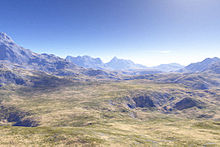
Computer animation is the art of creating moving images via the use of computers. It is a subfield of figurer graphics and animation. Increasingly it is created by means of 3D computer graphics, though 2nd calculator graphics are still widely used for stylistic, depression bandwidth, and faster existent-time rendering needs. Sometimes the target of the animation is the computer itself, simply sometimes the target is another medium, such every bit flick. It is likewise referred to as CGI (Computer-generated imagery or computer-generated imaging), especially when used in films.
Virtual entities may comprise and exist controlled past assorted attributes, such equally transform values (location, orientation, and scale) stored in an object's transformation matrix. Animation is the change of an attribute over time. Multiple methods of achieving animation exist; the rudimentary form is based on the creation and editing of keyframes, each storing a value at a given time, per attribute to be animated. The 2nd/3D graphics software volition modify with each keyframe, creating an editable curve of a value mapped over fourth dimension, in which results in animation. Other methods of animation include procedural and expression-based techniques: the one-time consolidates related elements of blithe entities into sets of attributes, useful for creating particle effects and crowd simulations; the latter allows an evaluated issue returned from a user-defined logical expression, coupled with mathematics, to automate blitheness in a anticipated way (user-friendly for controlling bone behavior beyond what a bureaucracy offers in skeletal organisation ready).
To create the illusion of move, an epitome is displayed on the computer screen so quickly replaced past a new image that is like to the previous image, but shifted slightly. This technique is identical to the illusion of movement in tv set and motility pictures.
Concepts and principles [edit]
Images are typically created by devices such as cameras, mirrors, lenses, telescopes, microscopes, etc.
Digital images include both vector images and raster images, but raster images are more usually used.
Pixel [edit]
![]()
In the enlarged portion of the image private pixels are rendered as squares and can be easily seen.
In digital imaging, a pixel (or picture element[23]) is a single point in a raster image. Pixels are placed on a regular two-dimensional grid, and are frequently represented using dots or squares. Each pixel is a sample of an original image, where more than samples typically provide a more than accurate representation of the original. The intensity of each pixel is variable; in color systems, each pixel has typically 3 components such equally red, green, and blue.
Graphics are visual presentations on a surface, such as a computer screen. Examples are photographs, drawing, graphics designs, maps, technology drawings, or other images. Graphics often combine text and illustration. Graphic blueprint may consist of the deliberate choice, creation, or arrangement of typography solitary, as in a brochure, flier, poster, web site, or volume without any other element. Clarity or effective communication may be the objective, association with other cultural elements may be sought, or merely, the creation of a distinctive manner.
Primitives [edit]
Primitives are basic units which a graphics system may combine to create more complex images or models. Examples would be sprites and graphic symbol maps in 2D video games, geometric primitives in CAD, or polygons or triangles in 3D rendering. Primitives may exist supported in hardware for efficient rendering, or the building blocks provided by a graphics awarding.
Rendering [edit]
Rendering is the generation of a second epitome from a 3D model by means of computer programs. A scene file contains objects in a strictly defined linguistic communication or data construction; information technology would incorporate geometry, viewpoint, texture, lighting, and shading information as a description of the virtual scene.[24] The data contained in the scene file is and then passed to a rendering programme to be processed and output to a digital image or raster graphics image file. The rendering plan is usually built into the reckoner graphics software, though others are bachelor as plug-ins or entirely split programs. The term "rendering" may exist by analogy with an "artist'south rendering" of a scene. Although the technical details of rendering methods vary, the general challenges to overcome in producing a 2d paradigm from a 3D representation stored in a scene file are outlined as the graphics pipeline along a rendering device, such as a GPU. A GPU is a device able to assist the CPU in calculations. If a scene is to wait relatively realistic and predictable nether virtual lighting, the rendering software should solve the rendering equation. The rendering equation does non account for all lighting phenomena, simply is a full general lighting model for computer-generated imagery. 'Rendering' is also used to describe the process of calculating furnishings in a video editing file to produce final video output.
- 3D project
- 3D projection is a method of mapping three dimensional points to a 2 dimensional plane. Every bit about electric current methods for displaying graphical information are based on planar ii dimensional media, the utilize of this type of projection is widespread. This method is used in most existent-fourth dimension 3D applications and typically uses rasterization to produce the final paradigm.
- Ray tracing
- Ray tracing is a technique from the family of epitome society algorithms for generating an image by tracing the path of light through pixels in an image plane. The technique is capable of producing a high caste of photorealism; ordinarily college than that of typical scanline rendering methods, only at a greater computational cost.
- Shading
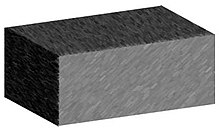
- Shading refers to depicting depth in 3D models or illustrations by varying levels of darkness. It is a process used in drawing for depicting levels of darkness on paper by applying media more densely or with a darker shade for darker areas, and less densely or with a lighter shade for lighter areas. There are various techniques of shading including cross hatching where perpendicular lines of varying closeness are fatigued in a grid pattern to shade an area. The closer the lines are together, the darker the area appears. Also, the farther apart the lines are, the lighter the area appears. The term has been recently generalized to mean that shaders are applied.
- Texture mapping
- Texture mapping is a method for adding item, surface texture, or color to a figurer-generated graphic or 3D model. Its awarding to 3D graphics was pioneered by Dr Edwin Catmull in 1974. A texture map is applied (mapped) to the surface of a shape, or polygon. This process is akin to applying patterned paper to a plain white box. Multitexturing is the utilize of more one texture at a time on a polygon.[25] Procedural textures (created from adjusting parameters of an underlying algorithm that produces an output texture), and bitmap textures (created in an paradigm editing application or imported from a digital camera) are, more often than not speaking, common methods of implementing texture definition on 3D models in computer graphics software, while intended placement of textures onto a model's surface often requires a technique known every bit UV mapping (capricious, manual layout of texture coordinates) for polygon surfaces, while non-uniform rational B-spline (NURB) surfaces accept their ain intrinsic parameterization used equally texture coordinates. Texture mapping every bit a subject also encompasses techniques for creating normal maps and bump maps that correspond to a texture to simulate height and specular maps to assist simulate shine and lite reflections, as well as environment mapping to simulate mirror-similar reflectivity, also chosen gloss.
- Anti-aliasing
- Rendering resolution-independent entities (such as 3D models) for viewing on a raster (pixel-based) device such as a liquid-crystal brandish or CRT television inevitably causes aliasing artifacts mostly forth geometric edges and the boundaries of texture details; these artifacts are informally chosen "jaggies". Anti-aliasing methods rectify such problems, resulting in imagery more pleasing to the viewer, simply can exist somewhat computationally expensive. Diverse anti-aliasing algorithms (such as supersampling) are able to be employed, and so customized for the well-nigh efficient rendering functioning versus quality of the resultant imagery; a graphics artist should consider this trade-off if anti-aliasing methods are to be used. A pre-anti-aliased bitmap texture being displayed on a screen (or screen location) at a resolution dissimilar than the resolution of the texture itself (such as a textured model in the distance from the virtual photographic camera) will exhibit aliasing artifacts, while whatever procedurally defined texture will always show aliasing artifacts as they are resolution-independent; techniques such as mipmapping and texture filtering help to solve texture-related aliasing problems.
Volume rendering [edit]
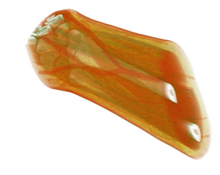
Volume rendered CT scan of a forearm with dissimilar colour schemes for muscle, fat, bone, and claret
Volume rendering is a technique used to display a 2D projection of a 3D discretely sampled data set. A typical 3D data set is a group of 2D slice images caused by a CT or MRI scanner.
Usually these are acquired in a regular pattern (e.g., one slice every millimeter) and ordinarily have a regular number of paradigm pixels in a regular blueprint. This is an example of a regular volumetric grid, with each volume element, or voxel represented past a unmarried value that is obtained by sampling the immediate surface area surrounding the voxel.
3D modeling [edit]
3D modeling is the process of developing a mathematical, wireframe representation of any three-dimensional object, called a "3D model", via specialized software. Models may exist created automatically or manually; the manual modeling process of preparing geometric data for 3D computer graphics is similar to plastic arts such as sculpting. 3D models may exist created using multiple approaches: utilise of NURBs to generate accurate and smooth surface patches, polygonal mesh modeling (manipulation of faceted geometry), or polygonal mesh subdivision (advanced tessellation of polygons, resulting in smooth surfaces similar to NURB models). A 3D model tin exist displayed as a 2-dimensional image through a process chosen 3D rendering, used in a calculator simulation of concrete phenomena, or animated direct for other purposes. The model can as well be physically created using 3D Printing devices.
Pioneers in computer graphics [edit]
- Charles Csuri
- Charles Csuri is a pioneer in estimator blitheness and digital fine art and created the offset computer art in 1964. Csuri was recognized by Smithsonian as the father of digital fine art and figurer animation, and as a pioneer of reckoner animation by the Museum of Modern Art (MoMA) and Association for Computing Machinery-SIGGRAPH.
- Donald P. Greenberg
- Donald P. Greenberg is a leading innovator in calculator graphics. Greenberg has authored hundreds of articles and served as a instructor and mentor to many prominent computer graphic artists, animators, and researchers such as Robert 50. Cook, Marc Levoy, Brian A. Barsky, and Wayne Lytle. Many of his old students have won Academy Awards for technical achievements and several have won the SIGGRAPH Achievement Laurels. Greenberg was the founding director of the NSF Eye for Computer Graphics and Scientific Visualization.
- A. Michael Noll
- Noll was one of the offset researchers to use a digital computer to create artistic patterns and to formalize the use of random processes in the creation of visual arts. He began creating digital art in 1962, making him one of the primeval digital artists. In 1965, Noll along with Frieder Nake and Georg Nees were the outset to publicly exhibit their computer art. During April 1965, the Howard Wise Gallery exhibited Noll's computer art along with random-dot patterns by Bela Julesz.
Other pioneers [edit]
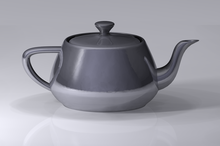
- Pierre Bézier
- Jim Blinn
- Jack Bresenham
- John Carmack
- Paul de Casteljau
- Ed Catmull
- Frank Crow
- James D. Foley
- William Fetter
- Henry Fuchs
- Henri Gouraud
- Marek Holynski
- Charles Loop
- Nadia Magnenat Thalmann
- Benoit Mandelbrot
- Martin Newell
- Fred Parke
- Bui Tuong Phong
- Steve Russell
- Daniel J. Sandin
- Alvy Ray Smith
- Bob Sproull
- Ivan Sutherland
- Daniel Thalmann
- Andries van Dam
- John Warnock
- J. Turner Whitted
- Lance Williams
- Jim Kajiya
Organizations [edit]
- SIGGRAPH
- GDC
- Bong Telephone Laboratories
- United States Armed Forces, specially the Cyclone reckoner and SAGE Project
- Boeing
- Eurographics
- IBM
- Renault
- The computer science department of the University of Utah
- Lucasfilm and Industrial Light & Magic
- Autodesk
- Adobe Systems
- Pixar
- Silicon Graphics, Khronos Grouping & OpenGL
- The DirectX division at Microsoft
- Nvidia
- AMD
Study of computer graphics [edit]
The study of calculator graphics is a sub-field of computer science which studies methods for digitally synthesizing and manipulating visual content. Although the term often refers to three-dimensional estimator graphics, information technology also encompasses two-dimensional graphics and image processing.
Equally an academic discipline, figurer graphics studies the manipulation of visual and geometric information using computational techniques. Information technology focuses on the mathematical and computational foundations of paradigm generation and processing rather than purely artful issues. Computer graphics is oftentimes differentiated from the field of visualization, although the 2 fields accept many similarities.
Applications [edit]
Computer graphics may be used in the following areas:
- Computational biology
- Computational photography
- Computational physics
- Computer-aided blueprint
- Estimator simulation
- Design
- Digital art
- Educational activity
- Graphic pattern
- Infographics
- Data visualization
- Rational drug pattern
- Scientific visualization
- Special Furnishings for movie theatre
- Video Games
- Virtual reality
- Web design
See also [edit]
- Estimator representation of surfaces
- Glossary of reckoner graphics
Notes [edit]
- ^ The uncanny valley is a hypothesis in the field of robotics and 3D computer animation, which holds that when man replicas await and deed virtually, but not perfectly, like actual human being beings, it causes a response of revulsion among human being observers. The concept "valley" refers to the dip in a graph of the condolement level of humans as a role of a robot's human being likeness.
References [edit]
- ^ "ACM Computing Nomenclature System ToC". www.acm.org . Retrieved 2020-04-28 .
- ^ What is Figurer Graphics?, Cornell University Program of Computer Graphics. Terminal updated 04/15/98. Accessed November 17, 2009.
- ^ University of Leeds ISS (2002). "What are computer graphics?" Archived 2015-01-06 at the Wayback Motorcar. Concluding updated: 22 September 2008
- ^ Michael Friendly (2008). "Milestones in the history of thematic cartography, statistical graphics, and data visualization".
- ^ Ross on MIT TECH TV 1959 https://www.youtube.com/sentry?v=ob9NV8mmm20
- ^ a b Carlson, Wayne (2003). "A Critical History of Computer Graphics and Animation". Archived from the original on April 5, 2007.
- ^ Jon Peddie: The History of Visual Magic in Computers: How Cute Images are Fabricated in CAD, 3D, VR and AR, Springer, 2013, p. 101, ISBN 978-1447149316
- ^ EDSAC 1 and after – a compilation of personal reminiscences, Retrieved eleven July 2019.
- ^ David Salomon (1999). Computer graphics and geometric modeling. p. ix
- ^ Peddie, Jon. "Famous Graphics Fries: NEC µPD7220 Graphics Brandish Controller – The first graphics processor chip". IEEE Computer Guild. Institute of Electrical and Electronics Engineers. Retrieved 1 Nov 2019.
- ^ Goldwasser, South.M. (June 1983). Computer Architecture For Interactive Display Of Segmented Imagery. Computer Architectures for Spatially Distributed Data. Springer Science & Business Media. pp. 75–94 (81). ISBN9783642821509.
- ^ a b Peddie, Jon. "Famous Graphics Chips: TI TMS34010 and VRAM". IEEE Computer Society. Institute of Electrical and Electronics Engineers. Retrieved 1 November 2019.
- ^ Peddie, Jon. "GPU History: Hitachi ARTC HD63484. The second graphics processor". IEEE Computer Order. Institute of Electric and Electronics Engineers. Retrieved 1 Nov 2019.
- ^ Data Processing Order of Japan. "LINKS-one Estimator Graphics Organization-Estimator Museum". Retrieved 15 June 2015.
- ^ http://www.vasulka.org/archive/Writings/VideogameImpact.pdf#page=29[ bare URL PDF ]
- ^ "System xvi – Namco System 21 Hardware (Namco)". Retrieved xv June 2015.
- ^ "System xvi – Taito Air Organization Hardware (Taito)". Retrieved 15 June 2015.
- ^ "Virtua Racing – Arcade (1992)". 15 Virtually Influential Games of All Time. GameSpot. 14 March 2001. Archived from the original on 2010-04-12. Retrieved 19 January 2014.
- ^ The Hereafter Of Calculator Graphics Daniel Sevo, 2005 (retrieved 26 Feb 2015)
- ^ Cinema: A Painstaking Fantasy Chris Taylor, Fourth dimension, 31 July 2000 (retrieved 8 Baronial 2012).
- ^ Final Fantasy: The Spirits Within at Box Office Mojo (retrieved 12 August 2012).
- ^ Greenberg, Ira (2007). Processing: Creative Coding and Computational Art. Apress. ISBN978-1-59059-617-3.
- ^ Graf, Rudolf F. (1999). Modern Dictionary of Electronics. Oxford, England: Newnes. p. 569. ISBN0-7506-4331-5.
- ^ "Lighting principles for 3D artists from picture and art". GarageFarm. 2021-07-21. Retrieved 2021-07-21 .
- ^ Blythe, David. Avant-garde Graphics Programming Techniques Using OpenGL. Siggraph 1999. (see: Multitexture)
Further reading [edit]
- L. Ammeraal and K. Zhang (2007). Calculator Graphics for Coffee Programmers, Second Edition, John-Wiley & Sons, ISBN 978-0-470-03160-5.
- David Rogers (1998). Procedural Elements for Reckoner Graphics. McGraw-Loma.
- James D. Foley, Andries Van Dam, Steven 1000. Feiner and John F. Hughes (1995). Computer Graphics: Principles and Do. Addison-Wesley.
- Donald Hearn and Thou. Pauline Baker (1994). Estimator Graphics. Prentice-Hall.
- Francis South. Hill (2001). Computer Graphics. Prentice Hall.
- John Lewell (1985). Calculator Graphics: A Survey of Current Techniques and Applications. Van Nostrand Reinhold.
- Jeffrey J. McConnell (2006). Computer Graphics: Theory Into Practise. Jones & Bartlett Publishers.
- R. D. Parslow, R. Westward. Prowse, Richard Elliot Green (1969). Figurer Graphics: Techniques and Applications.
- Peter Shirley and others. (2005). Fundamentals of figurer graphics. A.K. Peters, Ltd.
- 1000. Slater, A. Steed, Y. Chrysantho (2002). Calculator graphics and virtual environments: from realism to real-time. Addison-Wesley.
- Wolfgang Höhl (2008): Interactive environments with open up-source software, Springer Wien New York, ISBN 3-211-79169-8
External links [edit]
- A Critical History of Estimator Graphics and Animation
- History of Computer Graphics series of articles
- Calculator Graphics enquiry at UC Berkeley
- Thomas Dreher: History of Computer Art, chap. IV.ii Reckoner Animation
- History of Computer Graphics on RUS
Source: https://en.wikipedia.org/wiki/Computer_graphics
Posted by: vinsonpaun1939.blogspot.com

0 Response to "How To Import Sfm Animations Across Computers"
Post a Comment